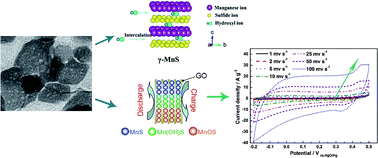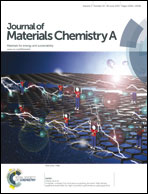Synthesis of graphene oxide anchored porous manganese sulfide nanocrystals via the nanoscale Kirkendall effect for supercapacitors†
Abstract
Graphene oxide (GO) anchored porous manganese sulfide nanocrystals (MnS/GO-NH3) were obtained via a facile hydrothermal method based on the Kirkendall effect. The honeycomb-like manganese sulfide nanocrystals (40–80 nm) and the three-dimensional sandwich structure endow the MnS/GO-NH3 with high supercapacitive performance when it was used as a supercapacitor material. The MnS/GO-NH3 electrode exhibits high specific capacitance (390.8 F g−1 at 0.25 A g−1), high rate capacity (78.7% retention at 10 A g−1) and stable cycle life (81.0% retention after 2000 cycles), which are superior to those of GO anchored MnS floccules (MnS/GO) and manganese hydroxide (Mn(OH)2/GO). As a novel material for supercapacitors, the charge–discharge mechanism of the MnS/GO-NH3 composite is proposed via detailed investigation. Asymmetric supercapacitors, assembled with MnS/GO-NH3 as the positive material and activated carbon as the negative electrode, reveal a high specific capacitance (73.63 F g−1), a high energy density of 14.9 W h kg−1 at 66.5 W kg−1 and even 12.8 W h kg−1 at a high power density of 4683.5 W kg−1.


 Please wait while we load your content...
Please wait while we load your content...